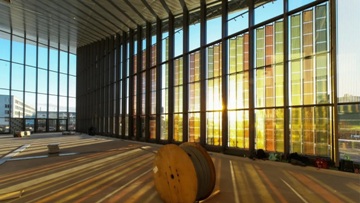
Researchers at the École Polytechnique Fédérale de Lausanne (EPFL) have discovered a way to create transparent photosensitizers molecules that can be activated by light and adsorb light across the entire visible light spectrum. Previous versions of DSCs were largely dependent on direct sunlight.
Previous versions of DSCs were largely dependent on direct sunlight.
Nergis Firtina
Created: Dec 22, 2022 10:17 AM EST
INNOVATION
/2022/12/22/image/jpeg/WHTZQVpO5WfrBvOdtjCSyUOOUHcEDQCO2PzGsw3f.jpg)
Grätzel solar cells achieve a new record
Mesoscopic dye-sensitized solar cells (DSCs),often known as the renowned Grätzel cells, were developed 32 years ago by Brian O'Regan and Michael Grätzel. DSCs use photosensitizers to turn light into electricity.
According to a report by Euronews, researchers at the École Polytechnique Fédérale de Lausanne (EPFL) have discovered a way to create transparent photosensitizers, molecules that can be activated by light and adsorb light across the entire visible light spectrum. Previous versions of DSCs were largely dependent on direct sunlight.
SEE ALSO
"Our findings pave the way for facile access to high-performance DSCs and offer promising prospects for applications as power supply and battery replacement for low-power electronic devices that use ambient light as their energy source,"explained the scientists in the press release.

Transparent, colored solar panels,
What are transparent solar panels?
DSCs can be made translucent, bendable, and in various colors for a reasonable price. Skylights, greenhouses, and glass facades already employ these transparent solar panels. The SwissTech Convention Center became the first public facility to use DSC's technology in 2012.
Additionally, portable electronic gadgets like headphones and e-readers, as well as the Internet of Things, can now use light from the environment to create electricity thanks to the commercial sale of lightweight, flexible versions of DSCs.
What now?
The packing of two newly created photosensitizer dye molecules can now be improved to improve the photovoltaic performance of the DSC, according to researchers from the EPFL groups of Grätzel and Anders Hagfeldt.
The new photosensitizers can gather light quantitatively over the whole visible spectrum when used together. The novel method entails pre-adsorbing a monolayer of a hydroxamic acid derivative on titanium dioxide's nanocrystalline mesoporous surface. This slows down the adsorption of the two sensitizers, allowing a layer of sensitizer to grow at the titanium dioxide surface that is well-ordered and densely packed.
MOST POPULAR
A method for optical absorption
The method produces DSCs with two or more distinct dyes that exhibit complementary optical absorption. It is a chemical fabrication process. Because cosensitization may be used to combine dyes that can absorb light from across the whole light spectrum, it has pushed the power-conversion efficiencies of DSCs toward record-breaking levels. However, cosensitization has also occasionally been shown to be inefficient because of the laborious molecular design, synthesis, and screening required to identify the ideal dye.
Using this method, the team was able to create DSCs for the first time with a power conversion efficiency of 15.2 percent in typical worldwide simulated sunlight after testing their long-term operational stability for 500 hours. The power conversion efficiency was between 28.4 percent and 30.2 percent over a broad range of ambient light intensities with exceptional stability by extending the active surface to 2.8 cm2.
The findings were published in Nature on October 26.
Study abstract:
Dye-sensitized solar cells (DSCs) convert light into electricity by using photosensitizers adsorbed on the surface of nanocrystalline mesoporous titanium dioxide (TiO2) films along with electrolytes or solid charge-transport materials. They possess many features including transparency, multicolour and low-cost fabrication, and are being deployed in glass facades, skylights and greenhouses. Recent development of sensitizers, redox mediators,and device structures has improved the performance of DSCs, particularly under ambient light conditions. To further enhance their efficiency, it is pivotal to control the assembly of dye molecules on the surface of TiO2 to favour charge generation. Here we report a route of pre-adsorbing a monolayer of a hydroxamic acid derivative on the surface of TiO2 to improve the dye molecular packing and photovoltaic performance of two newly designed co-adsorbed sensitizers that harvest light quantitatively across the entire visible domain. The best performing cosensitized solar cells exhibited a power conversion efficiency of 15.2% (which has been independently confirmed) under a standard air mass of 1.5 global simulated sunlight, and showed long-term operational stability (500 h). Devices with a larger active area of 2.8 cm2 exhibited a power conversion efficiency of 28.4% to 30.2% over a wide range of ambient light intensities, along with high stability. Our findings pave the way for facile access to high-performance DSCs and offer promising prospects for applications as power supplies and battery replacements for low-power electronic devices that use ambient light as their energy source.
موضوعات مشابه:

